
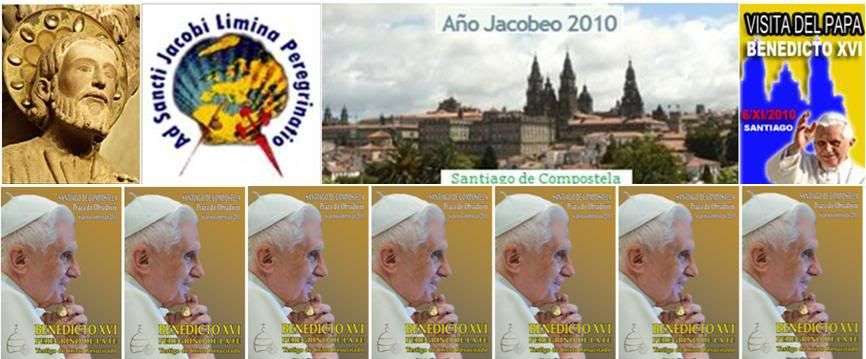 Santiago de Compostela
Santiago de Compostela
AIRPORT WELCOME
Benedict XVI arrived at Lavacolla airport in Galicia where he was welcomed by the Crown Prince of Spain, Felipe of Asturias, and his wife Princess Leticia. They also welcomed him to Valencia in 2006.
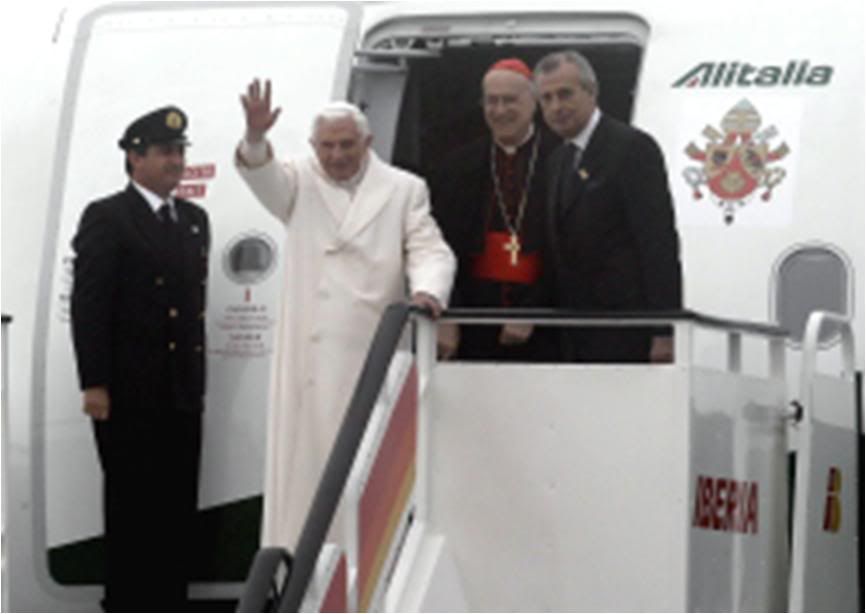
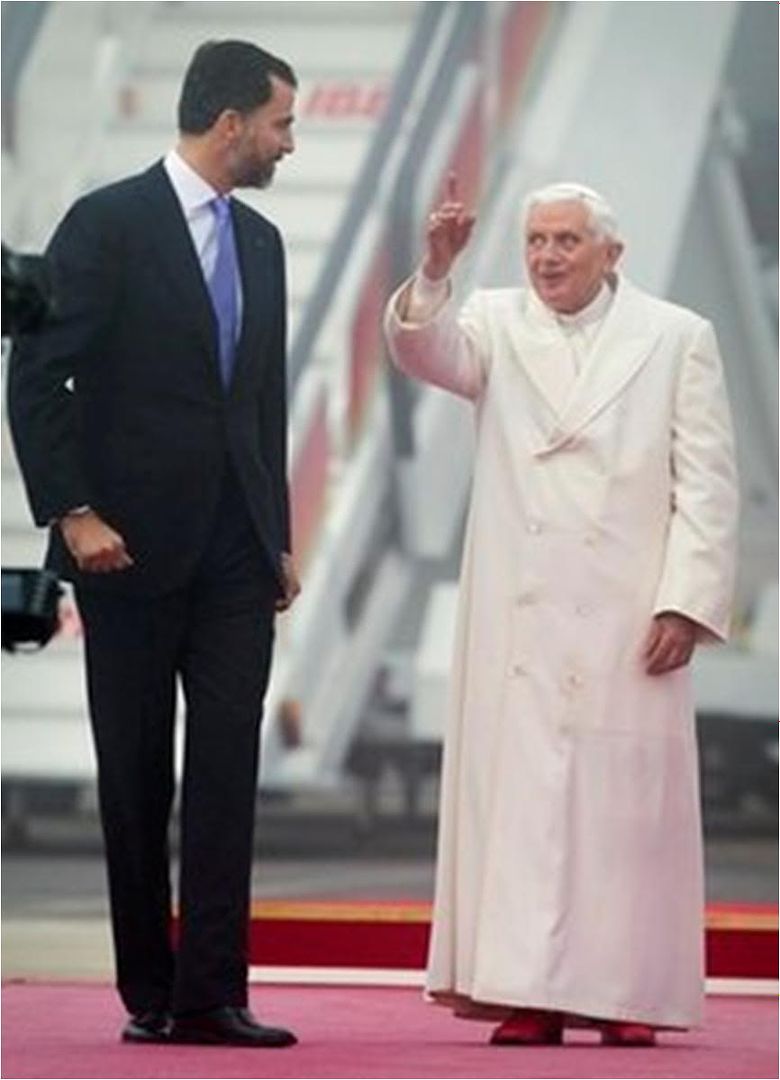
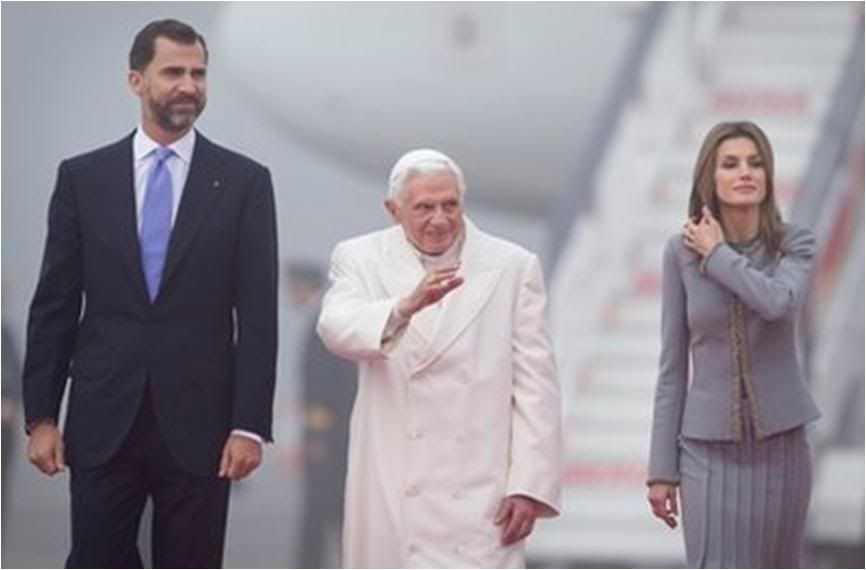
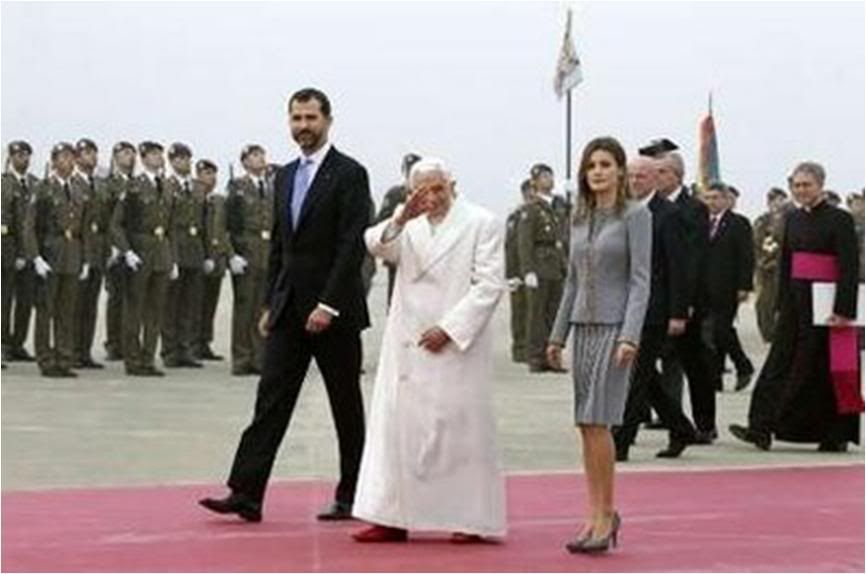
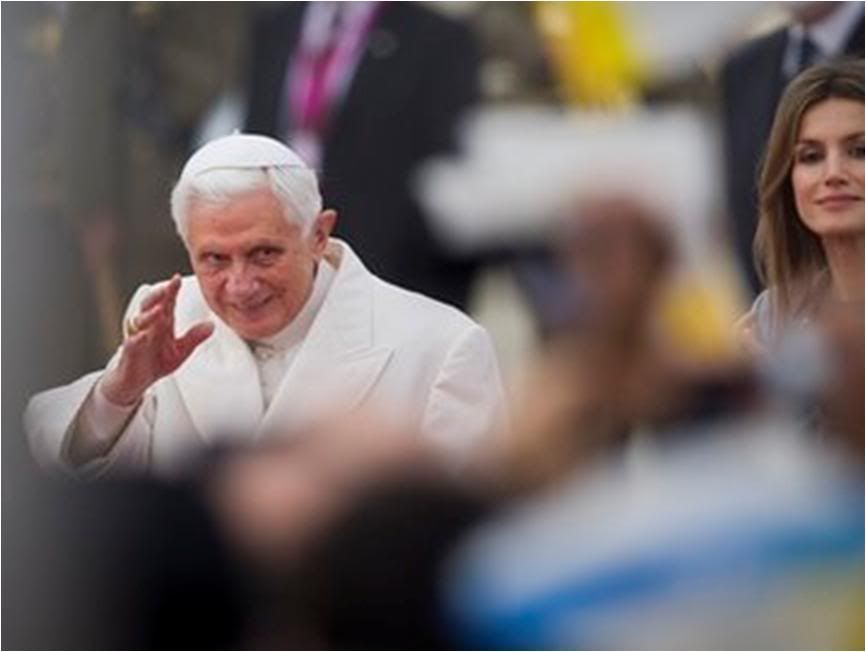
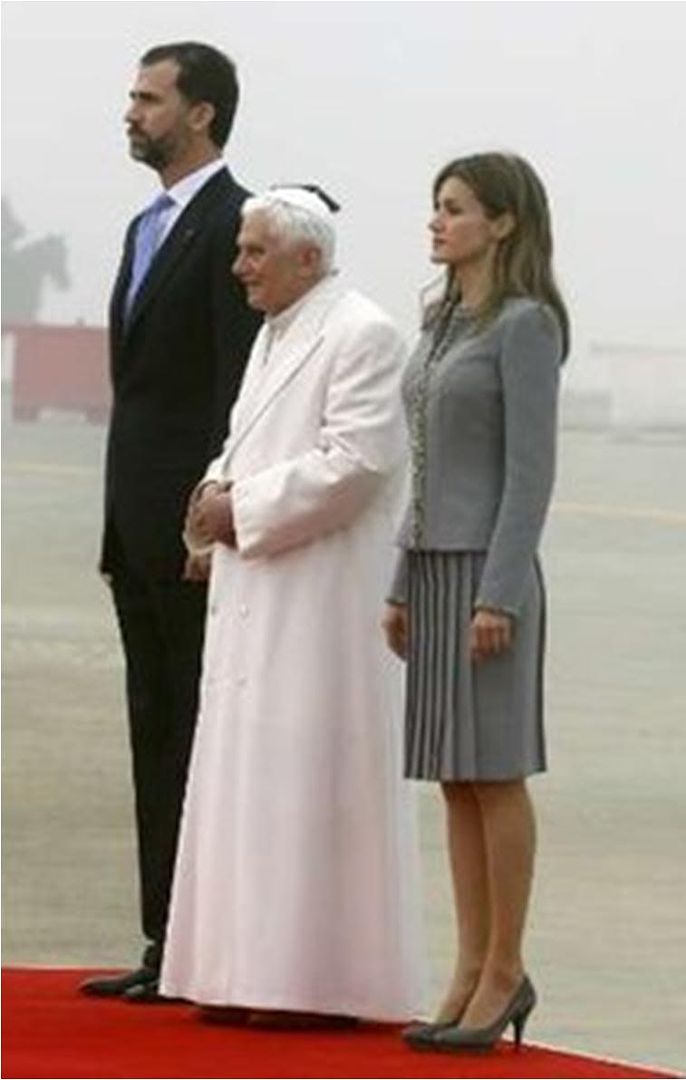
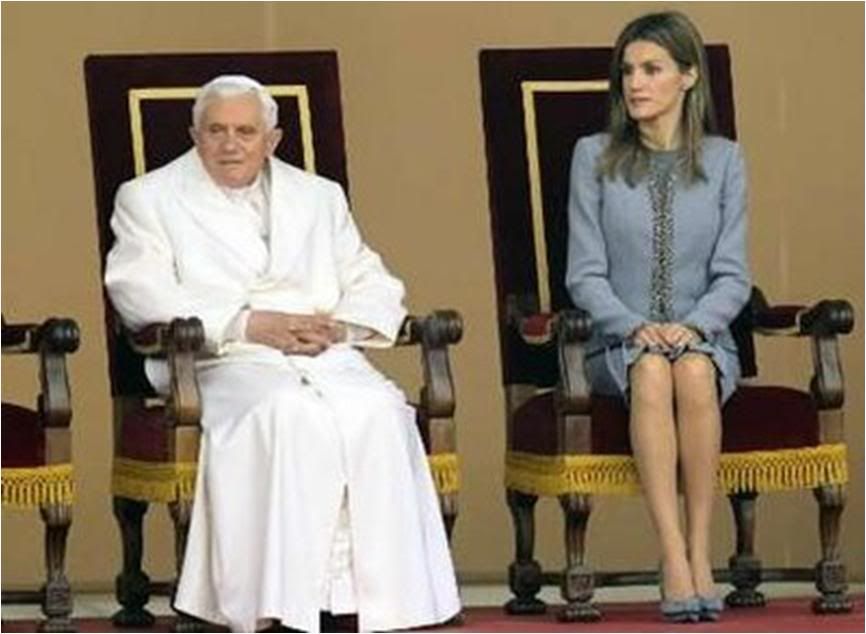 Pope arrives in Santiago
Pope arrives in Santiago

11 NOV 2010 (RV) - Pope Benedict XVI arrived in Santiago de Compostela on Saturday at the start of his two day visit to Spain.
He is visiting the third most important place of Christian pilgrimage after Jerusalem and Rome, thus completing the trifecta as the pilgrim Pope. Lydia O'Kane reports from Spain with the Pope.
Lydia O'Kane reports from Spain, where Pope Benedict arrived on Saturday "as a pilgrim" to "confirm Spain in its Christian faith":
As Pope Benedict’s plane touched down on the tarmac of the international airport at Santiago de Compostela it could hardly be seen for the thick fog that dominated the skyline.
Dressed in a white coat to guard against the winter chill, the Holy Father was greeted by the Prince of Asturias and his wife while in the background crowds could be heard shouting the Pope’s name and waving Vatican flags of welcome.
Following a greeting by Prince Felipe of Asturias, who spoke of the Pope’s visit as being one of “peace and hope”, the Holy Father addressing all those gathered, in Spanish, spoke about his joy at being on Spanish soil and being able to come as a pilgrim to this famed route at Santiago de Compostela.
With this speech the Pope alluded to key themes of this brief but “intense” visit as he called it, those being the themes of pilgrimage and Europe’s Christian identity.
The Pope spoke about the pilgrimage man is on in search of the truth and also the interior journey the Church follows to become a “transparent sign of Christ for the world.”
Recalling Europe and Spain’s Christian roots, the Pope noted this country’s contribution to the spreading of the Gospel through great Saints such as Ignatius of Loyola and Teresa of Jesus.
The Holy Father encouraged Spain and Europe to draw on its Christian foundations based on truth, freedom and justice adding that it is the moral, spiritual, and religious needs of this continent and not its material needs that are the requirements of “our common humanity.”
Finally, before a private meeting with members of Spain’s Royal family, and to the delight of those gathered the Pope paid homage to the people of Galicia in its official language Galician, expressing his closeness to the people of this region and the rest of Spain".
Santiago de Compostela is the capital of the Autonomous region of Gallica in the historic Northwest of Spain which has its own language and devolved government.
But what this regional capital is most famous for is the famed 9th century pilgrimage route, Camino de Santiago, or Way of St James which has been completed by pilgrims for hundreds of years aiming to reach the focal point of the Cathedral of St James.
Over its long history men and women both young and old have walked, cycled and even made the journey on horse back beginning, from France, Spain and Portugal, forging friendships and strengthen their faith along the way.
The Pope will not be walking the route himself but the Cathedral and its square will be the backdrop for a Mass presided over by the Holy Father on Saturday afternoon.
St James the Apostle or St James the Great is synonymous with Spain. He is the country’s Patron Saint, who preached the Gospel in both the Holy Land and in Iberia.
The story goes that he went back to Judea where he was martyred, only for his remains to be brought back by his disciples for burial at Santiago de Compostela at the site of the Cathedral that stands there today.
Fast forward to 2010, when the Successor of the Apostle Peter will come to this Holy place bringing his own message to the people, just like St James the Great.
The Pope is coming for the Holy Year which is celebrated every time St James’s feast day falls on a Sunday; 2010 was one of those years. A Holy Year usually brings an increased influx of pilgrims and this year has been no exception, but Holy Father’s visit has also peaked the pilgrims interest too.
The pilgrims office at Santiago de Compostela has seen a significant rise in registrations since the announcement of the Pope’s journey was made.
Pope Benedict last visited Spain in 2006 for the World Meeting of Families in Valencia, but in just 4 short years the country’s social and economic landscape has somewhat shifted.
Only this year a new Spanish law allowing abortion without restrictions in the first 14 weeks of pregnancy came into effect igniting a wave of protests from thousands of Spanish Catholics and like a number of other European countries Spain in the last few years has been severely hit by the global financial crisis which continues to bit hard prompting the government to introduce unpopular austerity measures.
But despite this economic gloom the second stage of Pope Benedict’s 32 hour visit will take him to one of the most vibrant cities in Europe, Barcelona.
Barcelona is the capital of another of Spain’s autonomous regions Catalonia, where Spanish, Catalan and Aragonese are all spoken. It is also a region which has witnessed years of bloodshed in the form of Catalan separatists who want independence from Spain.
In the second high point of this visit, the Holy Father will consecrate the Expiatory Temple of the Sagrada Familia in the heart of the city, a much loved iconic structure by the famed Spanish Architect Antoni Gaudi, which draws millions of tourists every year even if it is incomplete.
It is a temple where art meets faith, and a church that will be proclaimed a Basilica by Pope Benedict, symbolic perhaps of that New Evangelization he has so often spoken of in the face of an increasing secularism in traditionally Christian Europe.
ADDRESS OF HIS HOLINESS BENEDICT XVI
International Airport of Santiago de Compostela
Saturday, 6 November 2010
Your Royal Highnesses,
Distinguished national, regional and local authorities,
Your Grace the Archbishop of Santiago de Compostela,
Your Eminence the President of the Spanish Episcopal Conference,
Your Eminences and Excellencies,
Dear Brothers and Sisters,
Dear Friends,
I thank Your Highness for the respectful words which you have addressed to me in the name of all - words which are a touching echo of the sentiments of affection for the Successor of Peter which mark the sons and daughters of these noble lands.
I cordially greet those present and all who join us through the means of social communication, and I express my gratitude as well to all those who have worked generously, on the part of the Church and civil society, to make this brief yet intense Journey to Santiago de Compostela and Barcelona as fruitful as possible.
In his deepest being, man is always on a journey, ever in search of truth. The Church shares this profound human desire and herself sets out, accompanying humanity in its yearning for complete fulfilment.
At the same time, the Church pursues her own interior journey which, through faith, hope and love, leads her to become a transparent sign of Christ for the world.
This is her mission and her path: to be among men and women an ever greater presence of Christ “whom God made our wisdom, our righteousness and sanctification and redemption”(1 Cor 1:30). For this reason, I too have journeyed here, to confirm my brothers and sisters in the faith (cf. Lk 22:32).
I have come as a pilgrim in this Holy Year of Compostela and I bring in my heart the same love of Christ which led the Apostle Paul to embark upon his journeys, with a desire also to come to Spain (cf. Rom 15: 22-29).
I wish to join the great host of men and women who down the centuries have come to Compostela from every corner of this peninsula, from throughout Europe and indeed the whole world, in order to kneel at the feet of Saint James and be transformed by the witness of his faith.
They, at every step and filled with hope, created a pathway of culture, prayer, mercy and conversion, which took shape in churches and hospitals, in inns, bridges and monasteries. In this way, Spain and Europe developed a spiritual physiognomy marked indelibly by the Gospel.
Precisely as a herald and witness of the Gospel, I am also going to Barcelona, in order to nourish the faith of its welcoming and dynamic people. A faith sown already at the dawn of Christianity, one which blossomed and grew in the warmth of countless examples of holiness, giving rise to countless institutions of beneficence, culture and education.
A faith which inspired the gifted architect Antoni Gaudí to undertake in that city, with the fervour and cooperation of many people, that marvel which is the church of the Sagrada Familia. It will fall happily to me to dedicate that church, which reflects all the grandeur of the human spirit in its openness to God.
I am very pleased to be once again in Spain, which has given the world a constellation of great saints, founders and poets, like Ignatius of Loyola, Teresa of Jesus, John of the Cross, Francis Xavier, among many others.
in the twentieth century it raised up new institutions, groups and communities of Christian life and apostolic activity and, in recent decades, it has advanced in harmony and unity, in freedom and peace, looking to the future with hope and responsibility.
Moved by her rich patrimony of human and spiritual values, she seeks likewise to progress amid difficulties and to offer her solidarity to the international community.
These contributions and initiatives which have distinguished your long past, as well as the present, together with the significance of the two beautiful places I will visit on this occasion, lead me to look also to all the peoples of Spain and Europe.
Like the Servant of God John Paul II, who from Compostela exhorted the old Continent to give a new impulse to its Christian roots, I too wish to encourage Spain and Europe to build their present and to project their future on the basis of the authentic truth about man, on the basis of the freedom which respects this truth and never harms it, and on the basis of justice for all, beginning with the poorest and the most defenceless.
A Spain and a Europe concerned not only with people’s material needs but also with their moral and social, spiritual and religious needs, since all these are genuine requirements of our common humanity and only in this way can work be done effectively, integrally and fruitfully for man’s good.
[In Galician:] Dear friends, I renew my thanks for your kind welcome and for your presence at this airport. I renew my affection and closeness to the beloved sons and daughters of Galicia, Catalonia and the other peoples of Spain.
In commending my stay among you to the intercession of the Apostle Saint James, I ask God to bestow his blessings on all of you. Thank you very much/
Visiting Compostela:
A childhood wish fulfilled
by José Manuel Vidal
Translated from

Nov. 6, 2010
He was nine years old when he first dreamed of coming to Compostela. He had just entered the minor seminary, when one of his teachers sang the praises of the Camino de Santiago and the tomb of St. James to his fascinated pupils.
Compostela: for much of Europe, Finisterrae - the end of the earth - being at the western extremity of the Iberian peninsula.
Since then, the boy Joseph dreamed of one day coming to Compostela to make a pilgrimage to the cathedral of the 'field of stars' ('campo stela') and embrace James, the friend of Jesus.
All seminarians of his time dreamt of going to the three major pilgrimage sites of Christianity since the Middle Ages: Jerusalem, Rome and Compostela.
Many accomplished all three: to step foot in the Holy Land, Jesus's homeland; in Rome, to visit the tombs of Peter and Paul; and in Compostela, to the tomb of St. James. But ironically, Joseph Ratzinger had to wait until he became Pope to achieve all three.
As a young priest, he first visited and became familiar with Rome. It was the time of Vatican II and he was a young and brilliant theologian who found himselr rubbing elbows with the greates Church intellectuals of the day. He teamed up with other brilliant young theologians who helped lay the basis for that tremendous ecclesiastical spring.
He has visited the Holy Land a few times - first as a priest, later as Archbishop of Munich, then as Prefect of the CDF, and most recently as Pope, in May 2009.
He had one task undone: Santiago. He had been on the point of visiting Santiago a number of times, most recently in 2005, when he had everything planned to the last detail. He would make the pilgrimage with his brother Georg, anf they were to spend a week in Galicia, in order to soak themselves in the significance of the Jacobean experience for the region.
But he cancelled the trip that had been planned for spring, as John Paul II's condition worsened, and it was out of the question for him to leave Rome.
But today, Joseph Ratzinger will realize his childhood dream. He comes as a pilgrim but wearing the white robe only Popes wear. And when he embraces the image of St. James, he will surely give thanks that the Lord has granted him this wish.
And he will have a special thought for his brother George who could not join him on this trip. But Joseph will have much to tell him about. Much that will surely be good.
Reporting later today on the Pope's arrival and the airport ceremonies, Vidal wrote:
An emotional Pope
arrives in Galicia
Now he is in Galicia. And the Pope fulfills his dream of visiting Santiago de Compostela.
Upon setting foot in Lavacolla airport, and after greeting the Princes of Spain and authorities present, Benedict XVI used his first speech to give thanks, saying how happy he was to come as a pilgrim, even as he outlined the trajectory of his messages during this two-day visit to Spain.
With the basic message that we will surely hear again and again: an invitation to Spain and Europe to recover their Christian roots.
A visibly moved Pope who expressed his joy 'to be in Spain once again'....
[Vidal goes on to quote from the Holy Father's address.]
[Modificato da TERESA BENEDETTA 06/11/2010 15:45]